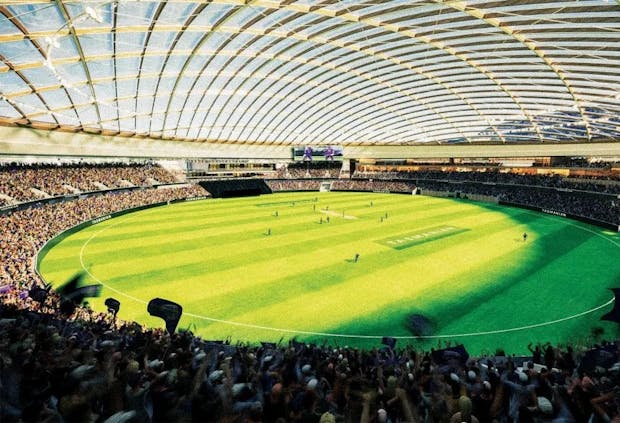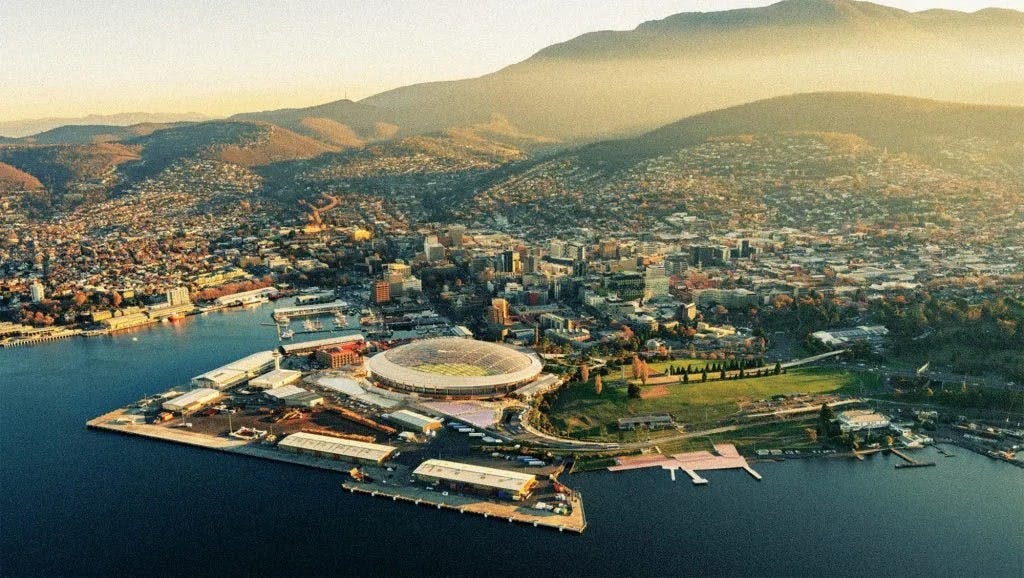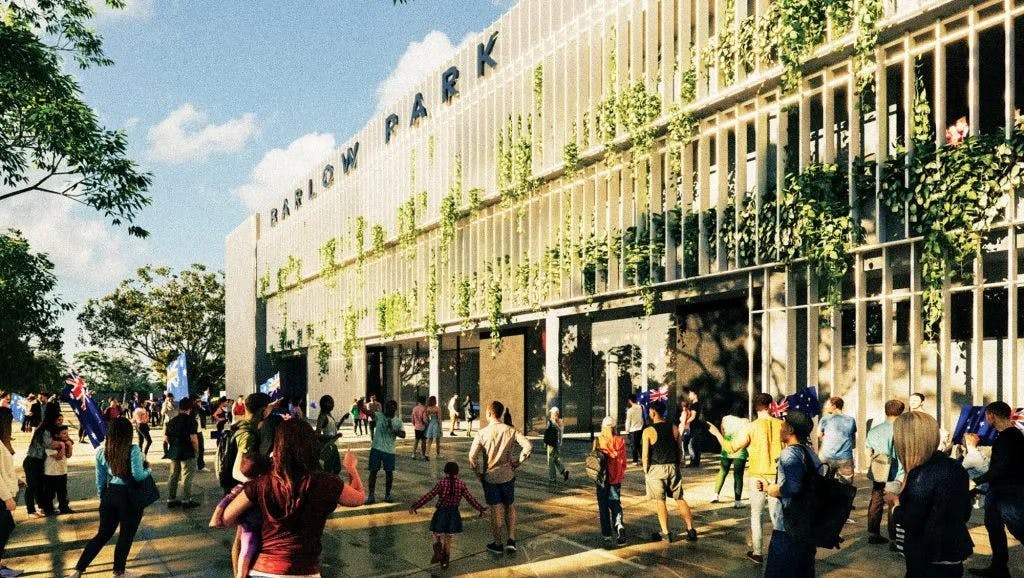
With a portfolio that includes Optus Stadium in Perth, Jakarta International Velodrome, Allianz Stadium in Sydney and Rod Laver Arena in Melbourne, Cox Architecture are right at the forefront of the stadium space. We caught up with directors Alastair Richardson and Richard Coulson to explore 10 trends that are shaping the future.
Trend 1:
Technological innovation and digital transformation
AR: “It’s been like a war of the screens in many stadiums, with video boards getting bigger and bigger and LED ribbons appearing on every surface. Integrated networks are also increasingly important so fans are always connected to the game, wherever they are in the stadium, while cashless is more commonplace than ever.
“I think the key with all of this is that the technology is constantly changing, so flexibility is really important. Technology might be out of date in five years’ time, so a lot of effort is being put into capacity, Wi-Fi and fibreoptic backbones.
“This enables a completely immersive environment. On the back of that, wearable technology is also growing – and there are opportunities for player performance data to be delivered to fans in a stadium in real time.”
RC: “Performance data is already being accessed by the teams, so it is a natural step to make it available to spectators. You can’t just expect people to fix their eyes on the field for a whole game anymore. Additionally, any technology that can cut queuing times, such as RFID-based innovations that mean you can just pick up food and drinks from an outlet without stopping to pay, will get increasingly popular.”
AR: “We’re seeing an enormous uplift in food and beverage (F&B) sales in Australian stadiums due to that technology, from something like $17 to $30 a head.”
Trend 2:
Stadium operators need to work harder than ever to attract fans
RC: “It should be remembered that fans still have a passion to be part of a collective and social experience at stadiums, and that is hard to replicate. However, it is important to amplify the social experience and make attending a venue as convenient and flexible as possible.”
AR: “Fans in stadiums want more space to linger, dwell and talk about the game, and they want different food options. Here in Melbourne, for example, multiple new restaurants have opened at Marvel Stadium that are all designed to create a unique event experience.
“The F&B element is really interesting. I’ve seen at outdoor concerts, for instance, ticket-holders getting Uber Eats deliveries to the entrance gate and then collecting them, with obvious implications for catering. How will fans consume food and drink within venues through the gig economy? I think that’s a fascinating question.”
Trend 3:
Premium experiences are replacing traditional hospitality
RC: “There is a greater variety of hospitality offerings than ever before and, increasingly, such clients do not want their guests to be trapped in a box. Rather than having 10 suites of 16 seats, sometimes it’s better if the 160 people are in a space where they could mingle together.”
AR: “The traditional corporate suite is exactly that: a tradition. Corporate clients are generally moving away from these and instead investing in high-spec retrofitting, while middle-tier club spaces are increasingly popular. You are also seeing younger fans attending fewer games, but spending more on making it a special occasion when they do attend.
“We can see the development of loyalty programmes transitioning into venues, be it either through membership models that are not based on club membership, to corporate partnerships with he likes of AMEX Centurion Clubs being associated with loyalty programmes. A leader in terms of ‘loyalty’ products to look at is the airline industry and their tiers of frequent flyers, and we will see the same development in stadia as part of the ‘premium’ offering.”

Trend 4:
The growing importance of the year-round venue
AR: “There is an increasing acceptance that it is not enough to just host 20 or so games a year. From a design perspective, building flexibility into a multi-use, community-focused stadium is essential, and new revenue streams are being opened up. We saw that at the Adelaide Oval, where we designed the first hotel in Australia to be completely integrated into a stadium’s footprint.”
RC: “The expectations of the community are really important, and there are practical considerations about how frequently a venue can be used in terms of turnaround times. However, hosting concerts can fundamentally change the revenue performance of a venue. That is why, for instance, the proposed Macquarie Point stadium in Hobart the team are working on is being designed to accommodate concerts as well as sport as part of a multi-purpose offering.”
AR: “Macquarie Point is a great example as we have taken steps to design specific elements that will make it more appealing for concert promoters – including a stage pocket and dedicated facilities for performers. Meanwhile, on the sporting side, this will be the first ‘indoor’ cricket stadium in the world, thanks to a transparent roof. The venue will initially host one-day international and T20 contests and, all being well, it will host Test cricket by 2030.
“More broadly though, the overall challenge we’re talking about is to increase the usage of stadiums. One key trend that will contribute towards this is the professionalisation of women’s sports, which will eventually lead to more games in front of bigger crowds at established venues. We are seeing the development of specific venues for women’s games that tend to be smaller, and between 13,000 and 20,000 seats, but demand will rapidly outgrow capacity.
“The aspiration of women’s professional sport has to be equality, and this includes access to the team’s home ground and spiritual heart. The notion that the ‘men’s game’ is the pinnacle of professionalism is yesterday’s thinking. The fastest growth in professional sport is the female game.”
Trend 5:
Accessibility is becoming impossible (and expensive) to ignore
AR: “We are big believers in equality of access, and that needs to be built into a stadium’s design. This goes beyond the restrooms, which are increasingly unisex in Australia. For example, a mother should be able to take their kid in a pushchair and rack it up to a platform so they can watch a game together.
“A venue that is a true community stadium should offer access to all. Traditionally, a wheelchair user and a single carer would come to a game. Nowadays, there may be four or five other friends or family members that want to come to a game with the wheelchair user, so there has to be flexibility to allow groups of people to be together.”
Trend 6:
Iconic Olympic Games venues are no longer just newbuild
RC: “It was great to see in Paris how iconic and historic locations were used. They broke new ground in terms of reusing venues. We are eight years out from the Olympic and Paralympic Games in Brisbane, which is a completely different animal, with a low-density, suburban landscape.
“But Queensland has a history of focusing on legacy because it has never really had the budgets to support ‘trophy’ stadiums. So the focus should be on legacy and community use from these venues, but there’s also a natural push and pull with some people getting anxious that plans are not ambitious enough to seize a once-in-a-generation opportunity.
“We are blessed in Australia that our legacy sports play in multi-sport venues, our rectangular professional sports in Brisbane – football, rugby league, rugby union – all play from a single venue, Suncorp Stadium. At the same time our oval-based stadiums support two professional sports, cricket and Australian rules football. With this usage profile we are already in a position where the legacy for the primary venues have a lasting outcome for the professional sports that call Brisbane home.”
Trend 7:
Stadiums are becoming anchors for major new precincts
AR: “All stadium infrastructure in Australia is essentially delivered through some form of government funding, given that they are community assets. This has led to a rise of public-private partnerships. What is now Marvel Stadium was basically the anchor for the complete redevelopment of the old Melbourne Docklands, but we are also seeing similar models in countries like Japan, as well as the United States of course. It was interesting to see the recent proposal for the revamp of Manchester United’s stadium talk about the potential transformation of the area around Old Trafford too.”
RC: “With stadium precincts, transport is the big thing here as it can often be a much higher infrastructure spend than the venue itself, and the two pieces have to go hand in hand. So, it takes political strength to get the necessary commitments.”
Trend 8:
Sustainability is no longer just a ‘nice to have’
RC: “Sustainability is about Legacy and Resources. It must involve considerations of legacy use and continuing flexible occupancy to avoid ‘white elephants’. Stadiums tend to be large pieces of infrastructure, so there needs to be focused and appropriate use of resources – and if they are only being used for one day a week, then how can those carbon footprints be justified?”
AR: “There is no question that sustainability is now a ‘must have’ for new stadiums. Here in Australia, there is legislation around water-harvesting and energy efficiency , for example. The sustainable options really depend on where you are in the world. For instance, it makes sense to use solar panels on roofs here in Australia due to our climate, but perhaps less so in Northern Norway. In India, we are working with Ahmedabad, which is one of the cities hoping to host the 2036 Olympics, whose aspirations are for a zero-carbon Games.
“We are seeing more and more stadiums designed for longevity – and this is a big focus of ours. For example, our founder Philip Cox designed Sydney Football Stadium, which opened in 1988. Our practice designed the new Sydney Football Stadium, which replaced it in 2022, and it will have the facilities, flexibility and economic sustainability to live for 50-plus years.
“Key to all sustainability issues with stadiums and arenas is usage. The notion that a stadium is only the home ground for the men’s professional team, for example, does not maximise the use of the asset. Professional female sport should change this outlook, but with this there are nuances in the way we design our venues to have a greater life. In Australia our major venues are averaging 60-80 event days per year, amongst the highest anywhere in the world.”

Trend 9:
AI is only getting bigger
RC: “AI is one of many tools that we already use. AI is able to churn through a lot of data and improve efficiency and better outcomes in stadium design. But great venues still need intuition and experience to ensure they reflect the city, the climate and the community they will belong to.”
AR: “AI is great at generating ideas, but it can’t create the essence of what creates a great fan experience in a stadium. Can AI recreate the unique atmosphere of the Anfield Kop, for example?
“Where AI has value is in its ability to harvest, collate and synthesise data led design, improving outcomes for the design from the outset. What it struggles with is an understanding of the interaction between all our senses and how these interact to create a unique venue, atmosphere and experience. These attributes are a innately human experience.”
Trend 10:
The sporting world is getting smaller
AR: “In the stadium space, there has been a commoditisation of design, but we believe strongly that venues should reflect the unique context of the setting, city and community. You look at redevelopments like FC Barcelona’s Camp Nou, which is retaining a strong connection to the city, rather than being a generic venue that could be situated anywhere. Stadiums should be part of the city and directly engage for 365 days a year. For that reason, I think we will shift towards venues having longer lifespans.
“In terms of the sporting world getting smaller, we are fortunate. We are expanding our outlook across Oceania and into Europe and North America, but being based in Australia allows us to observe rather than be immersed in all of these markets. That enables us to fuse the best elements of the various different stadium cultures worldwide to create truly unique venues.”
To find out more about the work that Cox Architecture do – and their perspectives on all things stadiums – visit their website.